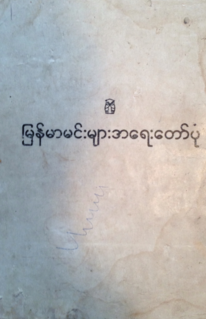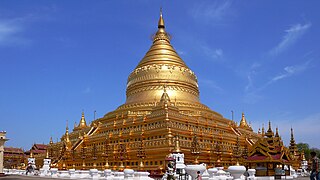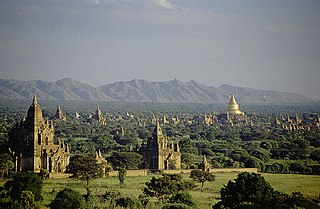
Lawkananda Pagoda is a Buddhist zedi located in Bagan, Burma. It was erected on the bank of the Ayeyarwaddy River, and built during the reign of King Anawrahta. It contains a replica of a Buddha tooth relic.

Kuthodaw Pagoda is a Buddhist stupa, located in Mandalay, Burma (Myanmar), that contains the world's largest book. It lies at the foot of Mandalay Hill and was built during the reign of King Mindon. The stupa itself, which is gilded above its terraces, is 188 feet (57 m) high, and is modelled after the Shwezigon Pagoda at Nyaung-U near Bagan. In the grounds of the pagoda are 729 kyauksa gu or stone-inscription caves, each containing a marble slab inscribed on both sides with a page of text from the Tripitaka, the entire Pali Canon of Theravada Buddhism.

Kyauktan Ye Le Pagoda (Burmese: ကျောက်တန်းရေလယ်ဘုရား [tɕaʊʔtáɴ jèlɛ̀ pʰəjá], formally Kyaikhmawwun Yele Pagoda is a Buddhist pagoda located in Kyauktan Township, Yangon Region, on a small island in Hmaw Wun Creek, a tributary of Yangon River. The pagoda was built with many Buddha's relics inside.

Tantkyitaung Pagoda, located across the Ayeyarwady River in Pakokku District, Magway Division, Myanmar (Burma) is a prominent Burmese Buddhist pagoda near the historic city of Bagan, believed to enshrine four tooth relics of Gautama Buddha.
The Royal Historical Commission of the Konbaung Dynasty of Burma (Myanmar) produced the standard court chronicles of Konbaung era, Hmannan Yazawin (1832) and Dutiya Yazawin (1869).
Maha Yazawin Thit is a national chronicle of Burma (Myanmar). Completed in 1798, the chronicle was the first attempt by the Konbaung court to update and check the accuracy of Maha Yazawin, the standard chronicle of the previous Toungoo Dynasty. Its author Twinthin Taikwun Maha Sithu consulted several existing written sources, and over 600 stone inscriptions collected from around the kingdom between 1783 and 1793. It is the first historical document in Southeast Asia compiled in consultation with epigraphic evidence.
Mizzimadetha Ayedawbon is a Burmese chronicle covering the history of Arakan after Konbaung Dynasty's annexation of Mrauk-U Kingdom from 1785 to 1816. It was written in 1823 by Ne Myo Zeya Kyawhtin, the Konbaung governor of Sandoway (Thandwe), who was born to a Rakhine (Arakanese) father and a Bamar (Burman) mother of Ava royalty.

Kawitharabi Thiri-Pawara Agga-Maha-Dhammarazadiraza-Gura, commonly known as Dhanyawaddy Ayedawbon is a Burmese chronicle covering the history of Arakan from time immemorial to Konbaung Dynasty's annexation of Mrauk-U Kingdom in 1785. It was written soon after the annexation to salvage Arakanese history after most of Mrauk-U's historical records were burned down by Konbaung forces in 1785. Rakhine Sayadaw, a Buddhist monk, tried to piece together the portions that escaped the indiscriminate destruction, and completed it in 1788. According to G.E. Harvey, a British colonial period historian, the chronicle may not be as reliable as it is "a third-hand piece of work".
Razadarit Ayedawbon is a Burmese chronicle covering the history of Ramanya from 1287 to 1421. The chronicle consists of accounts of court intrigues, rebellions, diplomatic missions, wars etc. About half of the chronicle is devoted to the reign of King Razadarit, detailing the great king's struggles in the Forty Years' War against King Minkhaung I and Crown Prince Minye Kyawswa of Ava.
Pawtugi Yazawin is a Burmese chronicle that covers the history of the Portuguese, especially their rule at Syriam (Thanlyin) from 1599 to 1613. The oral history was first compiled in the early 19th century by Father Ignacio de Brito and Johannes Moses. It was first published in 1918 in Yangon.

Hanthawaddy Hsinbyushin Ayedawbon is a 16th-century Burmese chronicle of King Bayinnaung of Toungoo Dynasty. Though it is a biographic chronicle, it is a detailed account of the reign. The detailed coverage begins in 1550, right after the death of King Tabinshwehti, and ends in 1579, two years before the end of the reign.

Nyaungyan Mintaya Ayedawbon is an 18th-century Burmese chronicle of King Nyaungyan of Toungoo Dynasty.
Hsinbyushin Ayedawbon is an 18th-century Burmese chronicle of the first four years of King Bodawpaya of Konbaung Dynasty. Despite the name Hsinbyushin, it is not the chronicle of Bodawpaya's famous brother King Hsinbyushin.

Alaungpaya Ayedawbon, also known as Alaung Mintayagyi Ayedawbon, is one of two biographic chronicles of King Alaungpaya of Konbaung Dynasty. Both versions trace the king's life from his purported ancestry from King Sithu II of Pagan Dynasty down to his death from an illness from his campaign against Siam in 1760. Both contains many details, though not all the same, of the king's 8-year reign.

Alaung Mintayagyi Ayedawbon (Burmese: အလောင်း မင်းတရားကြီး အရေးတော်ပုံ, also known as Alaungpaya Ayedawbon, is one of two biographic chronicles of King Alaungpaya of Konbaung Dynasty. Both versions trace the king's life from his purported ancestry from King Sithu II of Pagan Dynasty down to his death from an illness from his campaign against Siam in 1760. Both contains many details, though not all the same, of the king's 8-year reign.

The Shwezigon Pagoda Bell Inscription is a multi-language inscription found on the Shwezigon Pagoda Bell, donated by King Bayinnaung of Toungoo Dynasty and located at the Shwezigon Pagoda in Bagan, Burma (Myanmar). Written in Burmese, Mon, and Pali, the inscription lists the important events in the first six years of his reign. It is the only contemporary record in Burmese that calls the king "Conqueror of the Ten Directions", the title by which he is widely known in Mon and Thai.

Mongmit or Möngmit was a Shan state in the Northern Shan States in what is today Burma. The capital was Mongmit town. The state included the townships of Mongmit and Kodaung.
Sithu Thaw Kaung is a Burmese university librarian, historian and leading authority in Asian library studies. He specializes in the preservation and archival of traditional documents, including palm leaf manuscripts.
Maniket, from Pali: Maṇikakkha (မဏိကက္ခ), is considered to be the earliest extant play in modern-day Myanmar, complete with dialogue, song lyrics, and stage directions. The storyline of Manikhet is based on the Sattadhanu Jataka, the 20th story in the Paññāsa Jātaka, a non-canonical collection of stories of the Buddha's past lives from Lan Na.











